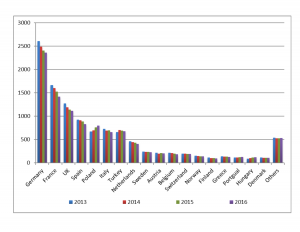Apart from in a handful of countries, European fruit juice and nectar (FJN) consumption is showing a decline over the period 2013 to 2016. The most notable country to have bucked the trend is Poland with a steady rise year on year during the period up 19% 2016 against 2013. Hungary (35%), Czech Republic (21%) and Slovakia (26%) are also showing notable increases for this period but from a much lower base.
Of the top four countries by consumption in 2016 – all are down by more than 10% against 2013: Germany (-10%); France (-15%); UK (-12%) and Spain (-10%).
When looking at trends by type of juice consumed, all are showing a decline with the exception of not from concentrate: 5.4% up for 2016 against 2015 and 14% up 2016 against 2012. Nectars are down 3.8% down 2016 against 2015 and 9% down 2016 against 2012 with juice from concentrate down 4.9% and 20% respectively for the same period.
Globally, North America is still the biggest consumer both by per capita consumption (24.8 litres per person in 2016) and by volume consumption (8,943 million litres in 2016). Interestingly in the EU both Malta (population 0.4 million) and Germany (population 82.6 million) consumed more per capita in 2016 than North America at 31.0 and 28.6 litres per person.
For a more detailed analysis of fruit juice consumption (orange, apple and pineapple) by country in Eastern Europe please click here.
Definitions
Fruit juice and Nectars
Juice: 100% pure fruit juice or vegetable juice with no added ingredients, except permitted minerals and vitamins for the purpose of fortification and permitted additives. Includes products: from concentrate, not from concentrate, chilled, ambient, frozen concentrated juice, smoothies. Excludes carbonated juice.
Nectars: 25-99% juice content
Diluted fruit/vegetable juice and pulp, to which sweetening agents (e.g. sugar, honey, syrups and/or sweeteners) need to be added for the purposes of production. Permitted minerals and vitamins for the purpose of fortification and permitted additives may be added. Whilst juice content is required to be equal to or in excess of 25% by volume, minimum juice content varies according to the fruit in question. Includes products: from concentrate, not from concentrate, chilled, ambient and smoothies.
Total fruit juices and nectars in EU (Million litres)
| 2012 | 2013 | 2014 | 2015 | 2016 | Difference 2016 Vs 2015 | |
| Total | 10357 | 9916 | 9589 | 9529 | 9299 | -2.4% |
| Total nectars | 3609 | 3473 | 3415 | 3420 | 3291 | -3.8% |
| Total fruit juice | 6748 | 6442 | 6175 | 6109 | 6008 | -1.6% |
| Total fruit juice from concentrate | 4945 | 4593 | 4311 | 4163 | 3958 | -4.9% |
| Total fruit juice not from concentrate | 1803 | 1849 | 1864 | 1946 | 2050 | 5.4% |
Largest EU FJN markets by volume consumption 2016
| Country | Million litres |
| Germany | 2361 |
| France | 1415 |
| UK | 1116 |
| Spain | 831 |
| Poland | 800 |
| Others | 2776 |
| Total | 9299 |
Largest EU FJN markets by per capita consumption 2016
| Country | Population (million) | Litres per person |
| Malta | 0.4 | 31 |
| Germany | 82.6 | 28.6 |
| Netherlands | 17 | 23.8 |
| Cyprus | 1.2 | 23.4 |
| Austria | 8.7 | 22.9 |
| Sweden | 10 | 22.5 |
Largest FJN markets by volume consumption by region 2016
| Region | Million litres |
| North America | 8943 |
| West Europe | 8208 |
| Asia Pacific | 7683 |
| East Europe | 4250 |
| Africa & Middle East | 3457 |
| Latin America | 3422 |
| Total | 35963 |
| EU 28 | 9299 |
Largest FJN markets by per capita consumption by region 2016
| Country | Population (million) | Litres per person |
| North America | 360.3 | 24.8 |
| West Europe | 420.5 | 19.5 |
| EU 28 | 512.4 | 18.2 |
| East Europe | 393.5 | 10.8 |
| Latin America | 585 | 5.8 |
| Africa & Middle East | 952.2 | 3.6 |
| Asia Pacific | 3697.5 | 2.1 |

Acknowledgment: This information is sourced from the European Fruit Juice Association (AIJN). The AIJN represents the industry from the fruit processors to the packers of the consumer products. AIJN’s foundation goes back to 1958. The AIJN office is situated in the heart of the Brussels European quarter.



